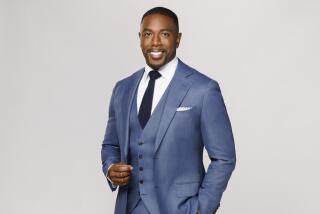At KCAL, prime-time news still in its prime
- Share via
KCAL news anchor Pat Harvey can still recall her edgy excitement generated decades ago by not only the imminent launch of an ambitious and historic broadcast but also by widespread predictions of failure.
It was March 5, 1990, as the now veteran broadcaster positioned herself behind the anchor desk, the focus of a sparkling new set on a Paramount Studios sound stage. After months of planning, a rash of hirings and upgrades that cost more than $30 million, she was on the front lines of an unprecedented experiment -- a nightly three-hour newscast. The occasion marked the first time a commercial station had devoted its evening programming to news instead of entertainment.
Many television news experts saw the maneuver by the station’s then owner, the Walt Disney Co., as a groundbreaking and expensive gamble. And more than just rivals viewed the enterprise as folly and destined for financial disaster.
“We were all very nervous because we knew how high the expectations were,” Harvey said. “We were also hearing a lot of cynicism. But actually, hearing all that stuff just pumped me up more.”
This month Harvey and her colleagues are celebrating the 20th anniversary of the prime-time block, currently known as the “KCAL 9 News at 8, 9 and 10 p.m.” The slate has remained intact -- except for occasional Lakers and Dodgers games -- while numerous other formats and configurations on other stations have come and gone.
The initial anchor team on the broadcast included the most iconic newsman on local TV, Jerry Dunphy. The silver-haired newsman, who died in 2002, had been wooed away from KABC Channel 7 with a five-year, multimillion-dollar contract. (Dunphy left KCAL after five years in a highly publicized jump to KCBS Channel 2.) He was teamed at the 8 p.m. hour with Jane Velez-Mitchell.
Harvey and investigative reporter David Goldstein are the only members of the initial on-air crew still at the station. Velez-Mitchell is the host of HLN’s “Issues with Jane Velez-Mitchell.”
The prime-time block has since become the centerpiece of KCAL’s brand. The average combined audience of the three newscasts this year is 543,000 viewers, an increase of 12% over the same period last year.
Harvey said the success was particularly gratifying because “we just have ourselves to depend on. We don’t have a lead-in or anything surrounding us.”
Station executives say the newscast, divided into one-hour installments, still works as a viable alternative to entertainment programming. Between 8 and 10 p.m., the station has local news coverage all to itself.
“It came on the air with guns blazing, and the guns are still blazing,” said Steve Mauldin, president and general manager of KCBS-KCAL, who joined the station last December. “The newscast is a very positive piece of our brand. And we don’t want to get in the way of what’s been successful.”
More important, the station has no plans to cut resources during a time when other stations across the country have been forced to reduce staff and curtail newscasts because of declining ad revenue and profits. Last month, KNBC eliminated its 11 a.m. news, and the past couple of years have seen the departure of highly paid anchors like KNBC’s Paul Moyer and KCBS’ Ann Martin and Harold Greene.
Though the newscast’s format has remained largely the same over the years, the owners have not. KCAL is now owned by CBS Corp. and is part of a duopoly with KCBS and shares space at CBS Studio Center in Studio City.
In 1990, Disney devoted considerable resources to launching its news block and made clear it would stick with it even if it lost money. The enterprise was supported by what was then the largest news staff in town, new cameras, state-of-the-art editing equipment, satellite links and a new set. And the station plucked on-air talent from a host of out-of-town stations.
The early days were freewheeling and exciting, said Harvey. With more resources the station was able to produce in-depth documentaries and showcase town-hall meetings and local debates.
“It was great to be able to do longer pieces instead of just going a minute and a half,” said Goldstein.
Still, it has not been all smooth sailing for the KCAL news. In its first week, then Los Angeles Times TV columnist Howard Rosenberg blasted the newscast, calling it “a technological fiasco.” He criticized the newscast as not having lived up to its heavy-duty hype.
“The perspective that super-anchor Jerry Dunphy has been promising viewers in infinite promos and ads has been largely absent, and the promised live coverage has been a gimmick, consisting mostly of reporters in the field from locales where nothing is happening or giving live intros (for no valid reason) to tape packages,” he wrote.
In late 1997, a year after the Young Broadcasting station group took over ownership of the station, management introduced a new set, twin anchor desks and flashier graphics. The news chunk was broken into half-hour segments for a faster-paced, more “viewer-friendly” approach.
Still, tweaks in its format haven’t impressed everyone. Rosenberg, who is a professor at USC, still finds plenty to criticize.
“Technically, they’ve certainly cleaned up their act, but the newscast is still very thin,” he said. He also took a shot at the duopoly’s similarities.
“They essentially give the same news,” he said. “It’s a microcosm of what’s wrong with TV journalism, with fewer voices being heard.”
Velez-Mitchell downplays the criticisms and still calls her time at KCAL invigorating.
“We all had such fun meeting this unique challenge,” she said. “It’s one of the highlights of my professional life.”
More to Read
The biggest entertainment stories
Get our big stories about Hollywood, film, television, music, arts, culture and more right in your inbox as soon as they publish.
You may occasionally receive promotional content from the Los Angeles Times.











